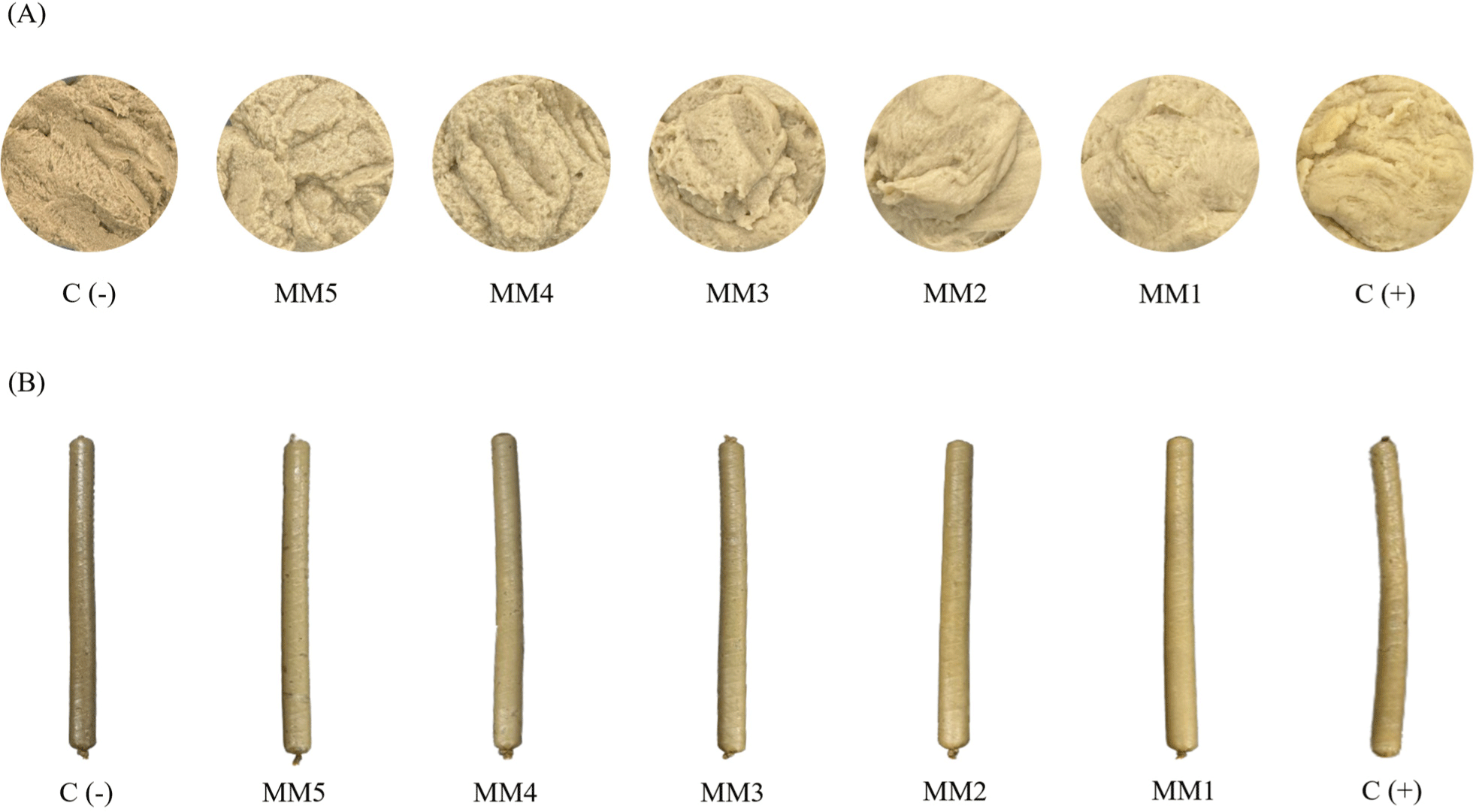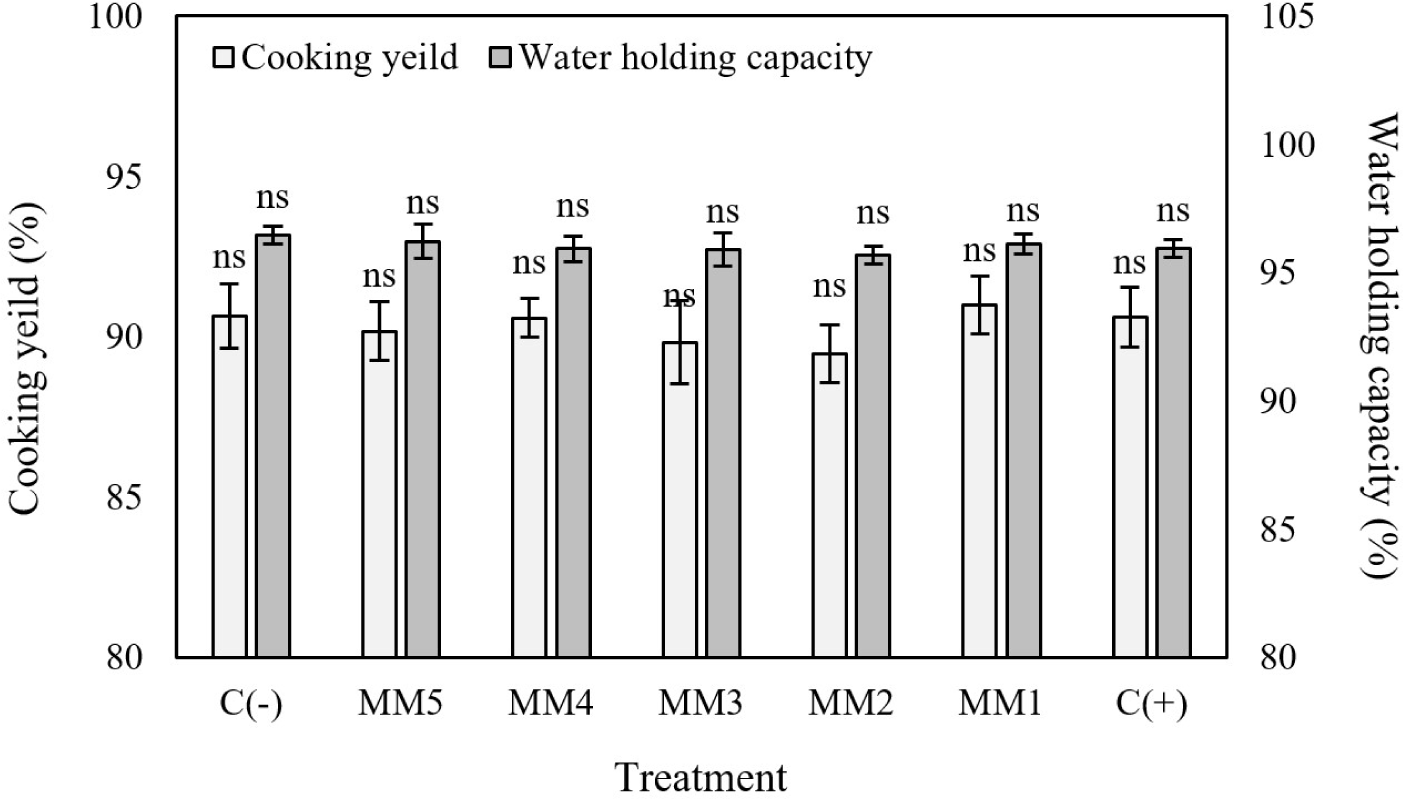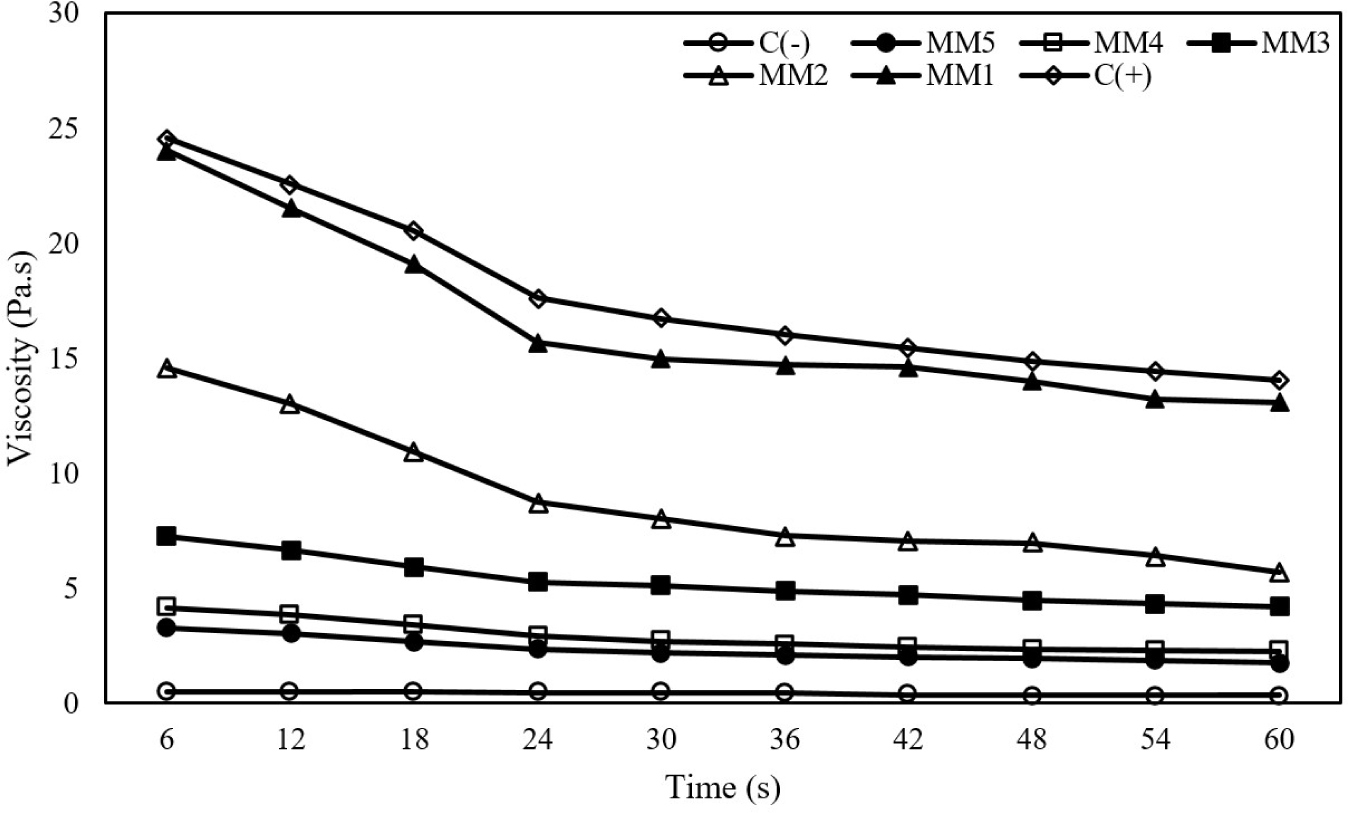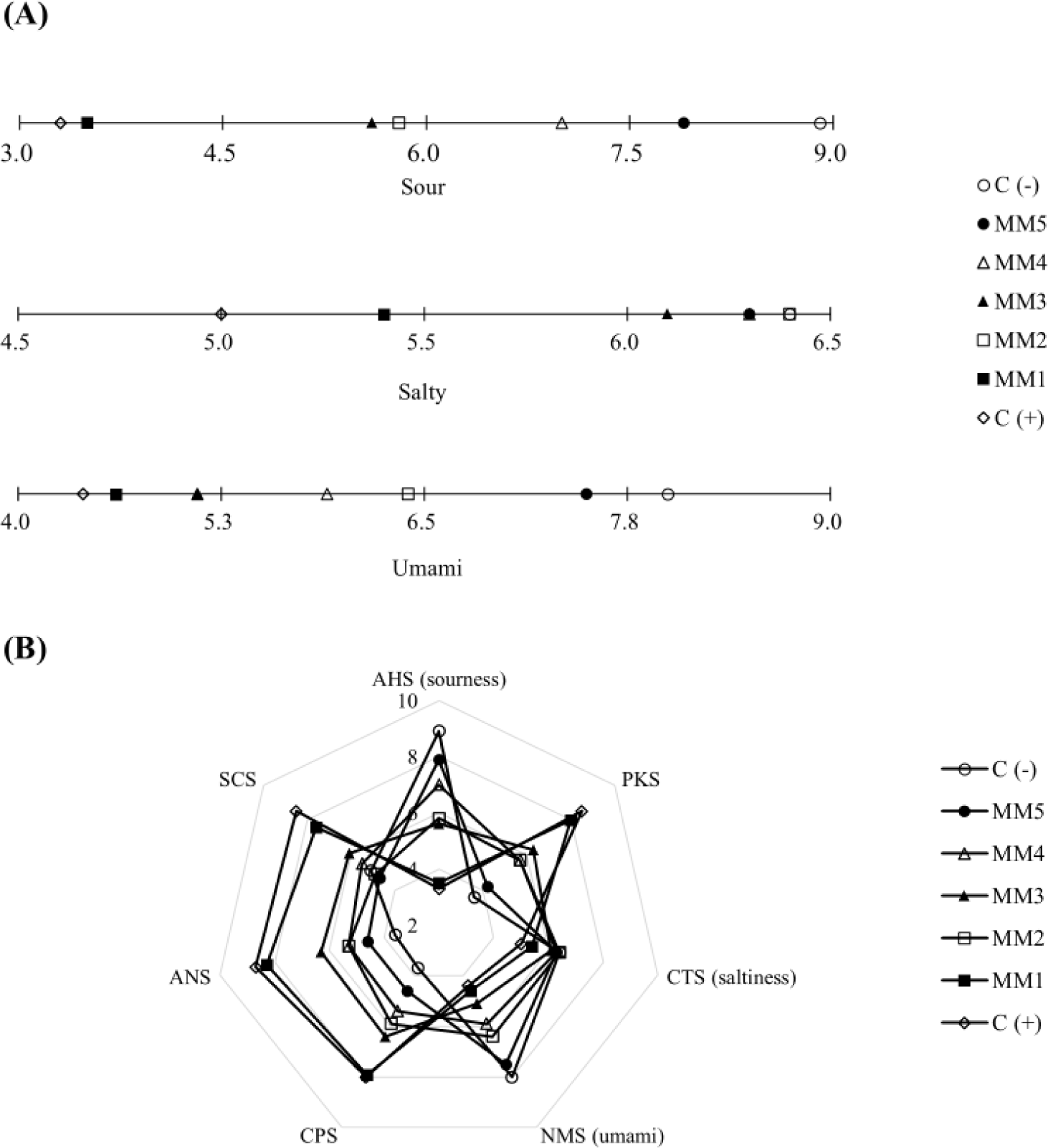Introduction
By 2050, the global population is predicted to reach 9 billion, and the demand for animal food is anticipated to reach 550 million tons. However, traditional livestock resources are insufficient to meet the growing demand for meat products. As sustainable food alternatives, “meat” products based on proteins derived from plants, microorganisms, and other sources are gaining attention (Sim et al., 2022). In this regard, Santhapur et al. (2024) have reported that the production of meat alternative products could solve global climate problems by reducing agricultural greenhouse gas emissions by more than 50% by 2050. Plant-based meat alternative products also offer health benefits to consumers, in that they are high in fiber, which can prevent cancer and diabetes, and are low in saturated fat, an excessive consumption of which can lead to obesity (Coffey et al., 2023). Sources of plant-based proteins commonly used include those from soybeans (legumes), wheat (cereals), and mushrooms (fungi), whereas a diverse range of other sources are currently being assessed as alternatives to animal proteins, including potatoes, oilseeds, microalgae, and mycoproteins (Schweiggert-Weisz et al., 2020).
Soy protein offers all nine essential amino acids, possesses the ability to form anisotropic fibrous structures, exhibits excellent gelling properties, and is cost-effective (Zhang et al., 2021). Due to its superior nutritional composition, functional characteristics, handling, and cost-efficiency, isolated soy protein is incorporated into meat products or utilized in the production of meat alternatives (Xue et al., 2024). Wheat gluten primarily serves as an ingredient to mimic the texture of meat by forming a meat-like fibrous structure through the formation of intermolecular disulfide bonds, which create a protein network (Dinani et al., 2023). Furthermore, it enhances viscoelasticity and cohesion, acting as a binder to maintain food stability, and is used in conjunction with soy protein in the production of meat alternatives (Chiang et al., 2019). However, plant-based meat alternatives using soybeans, wheat, etc. are still insufficient to display the texture unique to meat due to their high chewiness and high springiness, and mushroom mycelium are added to compensate for the negative perception of the unique smell of soybeans (Mandliya et al., 2022; Zhang et al., 2024c).
Mushroom mycelium, a fungal resource, is rich in protein, amino acids, and fiber, highlighting its potential health-promoting properties. It can be cultivated rapidly within 15–30 days via submerged fermentation (Mandliya et al., 2022). Furthermore, mycelium production requires minimal resources and space, utilizing agricultural waste, such as lignocellulose-rich plant husks, roots, and seeds, as growth media components. This demonstrates significant potential for sustainability (Maseko et al., 2025). Additionally, the productivity of mycelium can be enhanced by using various media (liquid or solid) containing carbon sources (e.g., glucose, sucrose) and nitrogen sources (e.g., amino acids, urea, ammonium nitrate). The produced mycelium is widely utilized across diverse industries, including construction materials, packaging, textiles, and meat alternatives (Maseko et al., 2025; Shin et al., 2025).
While the fruit bodies of Lentinula edodes have a lengthy cultivation period of 4–5 months with challenging production processes and conditions, L. edodes mycelium can be mass-produced quickly and consistently through liquid culture. Moreover, its rich amino acid profile and low fat content make it a suitable meat substitute (Kim et al., 2024; Yu et al., 2023a). Furthermore, mycelium’s high content of ribonucleotides, aspartic acid, and glutamic acid confers a meat-like flavor, while its filamentous structure imparts a meat-like texture (Singh et al., 2023). Commercial meat alternatives like MyForestTM (whole cut bacon made from mushroom mycelium) and QuornTM (made from Fusarium venenatum derived mycoprotein) are already available in the market (Maseko et al., 2025; Vandelook et al., 2021).
However, limited research has evaluated the physicochemical and textural properties of meat alternatives formulated with varying ratios of mushroom mycelium and other protein sources. Therefore, this study aims to evaluate the physicochemical and textural properties of L. edodes mycelium sausage with added isolate soy protein (ISP) and wheat gluten to improve its textural characteristics, thereby assessing its potential as a meat alternative.
Materials and Methods
Shiitake mushroom (L. edodes) mycelium was obtained from Ohsooup (Seoul, Korea) and cultured as follows. Aseptically isolated fruiting body tissue was obtained by inoculation on potato dextrose agar (PDA) solid medium and incubation at 25°C for 20 days. L. edodes mycelium inoculum cultures were obtained by taking a portion of shiitake mycelium cultured on PDA medium and inoculating it into 300 mL potato dextrose broth (PDB) liquid medium, homogenizing it with a high-speed homogenizer at 6,451×g for 40–60 seconds, and incubating it in a shaking incubator (temperature 25°C, stirring speed 1.75×g, air supply 0.5 vvm) for 10 days. For mass production, a liquid medium containing yeast extract 0.5% (w/v), glucose 2.0% (w/v), MgSO4-7H2O 0.05%, KH2PO4-12H2O 0.05% (w/v), and silicon-based antifoaming agent (LS-303) 0.05% was prepared. mycelium was recovered by pressure filtration using filter paper with a pore size within 10 μm and washed three times with distilled water to remove media components [filtration yield (w/w): 84%].
L. edodes mycelium and distilled water were mixed in a ratio of 1:20, sealed, packaged, and washed for 24 h in a 4°C refrigerator. The washed mycelium was then vacuum filtered using an electric aspirator (VE-11, JEIO TECH, Daejeon, Korea) and filter paper (Whatman No. 1, Whatman, Maidstone, UK) and used for sausage production. The mixing ratio of L. edodes mycelium sausage is shown in Table 1. [C (–): L. edodes mycelium 90%, corn starch 10%, salt 1.5%; MM5: L. edodes mycelium 50%, WG 40%, corn starch 10%, salt 1.5%; MM4: L. edodes mycelium 40%, ISP 10%, WG 40%, corn starch 10%, salt 1.5%; MM3: L. edodes mycelium 30%, ISP 20%, WG 40%, corn starch 10%, salt 1.5%; MM2: L. edodes mycelium 20%, ISP 30%, WG 40%, corn starch 10%, salt 1.5%; MM1: L. edodes mycelium 10%, ISP 40%, WG 40%, corn starch 10%, salt 1.5%; C (+): ISP 50%, WG 40%, corn starch 10%, salt 1.5%]. It was manufactured using L. edodes mycelium (moisture: 77.89%, protein: 5.05%, fat: 0.32%, ash: 2.84%, pH: 5.08, CIE L*: 48.66, CIE a*: 1.75, CIE b*: 18.03), ISP (pH: 7.94, CIE L*: 67.93, CIE a*: 0.70, CIE b*: 21.23), and wheat gluten (WG; pH: 6.49, CIE L*: 71.13, CIE a*: 0.60, CIE b*: 19.20) with reference to the method of Cho and Ryu (2023). The final gel was prepared by mixing twice for 1 min each using a bowl cutter (K-30, Talsa, Valencia, Spain), and the prepared gel was filled into a cellulose casing using a stuffer (EM-12, Mainca, St. Louis, MO, USA). The gel was then heated for 30 min in an 80°C chamber (10.10ESI/S, Alto Shaam, Menomonee Falls, WI, USA) and cooled for 30 min at room temperature before being used in the experiments. The gel before cooking and the sausage after cooking with the addition of L. edodes mycelium are shown in Fig. 1.

The proximate composition of L. edodes mycelium sausage was determined according to the AOAC method (2016), and the moisture content was analyzed by the normal pressure drying method (AOAC 950.46), the crude protein content by the Kjeldahl method (AOAC 992.15), the crude fat content by the Soxhlet method (AOAC 960.39), and the ash content by the direct painting method (AOAC 920.153) and expressed as a percentage.
Four grams of L. edodes mycelium sausage was added to 16 grams of distilled water and homogenized for 1 min using an ultra turrax (HMZ-20DN, Pooglim Tech, Seoul, Korea) set at 6,451×g speed. Subsequent measurements were made using a pH meter (Model S220, Mettler-Toledo, Schwerzenbach, Switzerland) calibrated with pH 4.01, pH 7.00, and pH 10.00 buffer solutions (Suntex Instruments, New Taipei City, Taiwan).
L. edodes mycelium sausage cross sections were measured for CIE L*, CIE a*, and CIE b* using a colorimeter (CR-10, Minolta). The standard color was a white standard plate with a CIE L* value of +97.83, CIE a* value of –0.43, and CIE b* value of +1.98.
The cooking conditions are the same as the sausage making process, and the weight of L. edodes mycelium sausage before and after cooking was weighed and substituted into the following Eq. (1).
Five grams of L. edodes mycelium sausage was wrapped in filter papers (Watman No. 1, GE Healthcare, Chicago, IL, USA) and placed in a conical tube. The samples were then centrifuged for 10 min using a centrifuge (Supra R22, Hanil, Deajeon, Korea) set at 109×g, 4°C. After centrifugation, the sample was weighed and calculated by substituting the following Eqs. (2)–(4).
The viscosity of L. edodes mycelium sausage emulsions was measured at 35°C for 1 min at a head speed of 30 rpm using a rotational viscometer (MerlinVR, Rheosys, Hamilton Township, NJ, USA) equipped with 30 mm parallel plates 1 mm gap.
L. edodes mycelium sausages were cut into 1 cm high slices and their texture profiles were measured using a texture analyzer (TA 1, Lloyd, London, UK) equipped with a 20 mm cylinder probe under the following analytical conditions: pre-test speed 2.0 mm/s, post-test speed 5.0 mm/s, maximum load 2 kg, head speed 2.0 mm/s, distance 8.0 mm, and force 5 g. The measurements were performed at hardness (kgf), springiness (%), cohesiveness (%), chewiness (kgf) and gumminess (kgf) were calculated using.
Vials containing 2 g of L. edodes mycelium sausage were measured using an electronic nose (E-nose; HERACLES-2-E-NOSE, Alpha MOS, Toulouse, France) equipped with two columns MXT-5 (Restek, Bellefonte, PA, USA) and MXT-1701 (Restek) at 70°C. The data were analyzed using the program Alphasoft (Alpha MOS) under the following conditions: reaction time 110 s, injection volume 5,000 μL, injection rate 125 μL/s, injection site temperature 200°C, detector temperature 260°C.
L. edodes mycelium sausage and distilled water were mixed in a 1:5 ratio and homogenized using an ultra turrax (HMZ-20DN, Pooglim Tech) set at 6,451×g for 1 min. The supernatant was then extracted by centrifugation using a centrifuge (Supra R22, Hanil) set at 437×g, 4°C for 10 min. The supernatant, diluted 1000-fold with distilled water, was then measured using an electronic tongue (E-tongue) system (Astree 5, Alpha MOS), and the signal of the flavor components represented by each sensor was determined using CTS (salty), NMS (umami), AHS (sour) sensors, PKS, ANS (standard sensor), and SCS, CPS (sensors).
The sensory evaluation was approved by the Kongju National University Institutional Review Board (Authority No: KNU_IRB_2024-124). Afterwards, 15 panelists were selected and familiarized with the professional knowledge and evaluation criteria for the sample in question before conducting a sensory evaluation. The L. edodes mycelium sausage were evaluated on a 10-point scale for appearance, flavor, off-flavor, texture, juiciness, and overall acceptability per treatment, and the evaluations were averaged and compared (appearance/flavor/off- flavor: 10=positive, 1=negative; texture: 10=firm, 1=soft; juiciness: 10=much juicy, 1=less juicy).
All experiments were repeated at least three times to analyze the results, and the mean and SD of the results were expressed using SAS (version 9.4 for window, SAS Institute, Cary, NC, USA). One way analysis of variance was used to analyze the experimental results, and significant differences (p<0.05) were tested by Ducan’s multiple range test.
Results and Discussion
The proximate composition of L. edodes mycelium sausages is shown in Table 2. Moisture content was significantly higher in C (–) samples, whereas it was significantly lower in C (+) samples with a decline in mycelium content (p<0.05). Protein content was significantly lower in C (–) and MM5 samples and increased with an increase in soybean protein from MM4 onward (p<0.05). Fat content declined with a reduction in mycelium content, whereas significantly higher ash content were detected in C (–) and MM5 samples (p<0.05), although showed no significant differences among the other groups (p>0.05). Mushrooms are rich in dietary fiber, low in fat, and contain minerals (e.g., sodium and calcium), trace elements (e.g., zinc and copper), and β-glucan, a soluble dietary fiber (Mazumder et al., 2024). Dietary fibers such as β-glucan have a porous structure, which enhances their capacity to bind and retain water, thereby increasing the water content with increased solubility as more soluble fibers are produced during high-temperature processes (Boylu et al., 2023). Furthermore, Cheung (1996) has reported a higher total dietary fiber content in the mycelium than in the caps and stems of L. edodes. This indicates that the dietary fiber in the mycelium may have contributed to an increase in water retention, and that the high water content in the mushroom mycelium may have contributed to the higher water content with increasing mycelium content. The protein content of L. edodes mycelium is about 26%, the protein content of ISP is more than 90%, and the protein content of WG is more than 80% (Astawan and Prayudani, 2020; Schopf et al., 2021; Wu et al., 2023). The protein content of the final product is positively correlated with the protein content of the raw material, so that the lower the protein content of the main raw material, the lower the protein content of the final product (Chiang et al., 2020). Accordingly, it is judged that the protein content of the sausage increased as the amount of L. edodes mycelium with low protein content decreased, and the high-protein raw material WG was added and ISP increased. The fat and ash contents of mushroom mycelium range from 1.73% to 24.65% and 1.91% to 6.97%, respectively, and typically has a higher fat content than most fruiting bodies, owing to its higher capacity to synthesize fat when grown in submerged culture (Ulziijargal and Mau, 2011). In addition, the fat and ash contents of ISP are less than 6.3% and 3.2%, respectively, whereas the corresponding contents in WG are 0.6% to 2.1% and 0.7% to 1.2% (Cho et al., 2024; Schopf et al., 2021). Consequently, given the lower fat and ash contents of ISP and WG than those in the mycelium of L. edodes, there was reduction in the fat and ash contents of ISP and WG with increasing amounts of ISP and WG. Similarly, Kang et al. (2022) reported that replacing meat with an emulsion made of soybean and wheat gluten increased the protein content while relatively decreasing the fat content, which was similar to this study.
The pH and color of sausages produced from L. edodes mycelium are shown in Table 3. The pH results revealed significant increase in values (p<0.05) with a reduction in mycelium content, which might be attributed to the relatively low pH of the mycelium (5.08) compared to that of ISP (7.94) and WG (6.49), respectively. Accordingly, it is believed that the pH increased with the addition of WG and an increase in ISP content. In this regard, Wu et al. (2018) reported that the pH of ISP was 7.45. Similarly, Chiang et al. (2019) found that pH increased with an increase in the concentration of soy protein in meat analogs using soy protein and WG, which is consistent with our findings. Kang et al. (2022) reported that as the proportion of meat replacement with an emulsion made of soybean and wheat gluten (pH 6.60) increased, the pH of sausages increased, which was similar to that in this study, and that the increase in pH could contribute to increasing the cooking yield of sausages.
The color results showed that the CIE L* and CIE b* values tended to increase as the mycelium content decreased, and the CIE a* value tended to decrease as the mycelium content decreased. Lee et al. (2023) reported that the high CIE L* inherent in white wood mushroom increased the CIE L*and CIE b* of the patties in meat alternative patties with white wood mushroom. Accordingly based on the color data for mycelium obtained in this study (CIE L*: 48.66, CIE a*: 1.75, CIE b*: 18.03), ISP (CIE L*: 67.93, CIE a*: 0.70, CIE b*: 21.23), and WG (CIE L*: 71.13, CIE a*: 0.60, CIE b*: 19.20), we reasoned that the relatively high CIE a* of mycelium, the relatively high CIE L*of ISP and WG, and the CIE b* of WG influenced the color of the sausages. An increase in CIE a* is associated with a decrease in CIE L*, whereas an increase in CIE b* contributes to an increase in CIE L*. Additionally, an increase in the CIE a* of meat tends to be positively perceived by consumers (Turcu et al., 2020). Conversely, Altmann et al. (2023) have reported that compared with darker red meat, consumers prefer red meat with higher CIE L* and CIE b*. Consequently, we believe that the observed increase in CIE L* and CIE b* due to ISP and WG addition could alleviate any negative consumer perception arising from a reduction in CIE a*.
The cooking yield and water holding capacity of L. edodes mycelium-based sausages are shown in Fig. 2. The cooking yield results indicated a value of approximately 90% in all control and treatment groups, with no significant differences among them (p>0.05). Similarly, water-holding capacity values were approximately 95% in all control and treatment groups, which also did not differ significantly (p>0.05). To promote an increase in cooking yield, it is necessary to reduce water loss by strengthening the bonds between water and proteins (Kang et al., 2021). Given that cooking yield and water-holding capacity are positively correlated, an increase in water-holding capacity would accordingly facilitate an increase in cooking yield (Park and Kim, 2016). Dietary fiber and ISP have high water-holding capacities, which enhance functional properties such as the yield and water-holding capacity of meat products (Lee et al., 2017). Furthermore, it has been established that WG protein enhances water-holding capacity via interactions with water molecules (Nguyen et al., 2024). Similarly, Starch is also used to improve the texture of food by absorbing water during the heating process to increase volume and increasing gel strength (Wu et al., 2020). The mycelium of L. edodes contains polysaccharides such as chitin and β-glucan, and the molecular structure of polysaccharides containing hydrophilic groups reduces water loss by maintaining a stable structure even during the heating process (Eliuz and Ayas, 2024; Zhou et al., 2022; Zhuang et al., 2020). Consequently, we assume that the high cooking yield values obtained for the control and all treatment samples in this study can be attributed to the presence of dietary fiber from the mycelium, ISP, WG, and starch, which contributed to enhanced water retention. Additionally, mycelium polysaccharides likely played a role by maintaining a stable structure during heating. In this regard, Gao et al. (2015) have demonstrated that soy protein isolates and polysaccharide mixtures can enhance emulsion stability, cooking yield, and water-holding capacity, due to their capacity to bind and retain moisture, which is similar to our findings in this study. Likewise, Cho and Ryu (2023) found that the cooking yield of patties prepared using soy protein and oyster mushrooms increased concomitantly with an increase in the water-holding capacity of the patties. Contrastingly, Mandliya et al. (2022) have reported that the water absorption capacity and water-holding capacity increased with an increase in the contents of mycelium consisting of filamentous fiber structures in meat analogs prepared using isolated pea protein and Pleurotus eryngii mycelium powder. Consequently, future studies are needed to investigate the manufacturing of sausages using L. edodes mycelium prepared in powdered form.

The viscosities of L. edodes mycelium-based sausages are shown in Fig. 3. The lowest viscosity values were observed in C (–) samples, which contained the highest amounts of L. edodes mycelium in this study. Conversely, viscosity increased as the amount of added mycelium decreased, with the highest viscosity detected in C (+) samples, which contained no mycelium. For the MM2, MM1, and C (+) samples, we detected a significant reduction in viscosity with time up to 24 s, and thereafter, values declined gradually. Comparatively, the C (–), MM5, MM4, and MM3 samples were characterized by a steady and gradual decline in viscosity over time. Viscosity is a quality criterion that is associated with the binding force between sausage emulsion constituents, which influences the texture of the final product. Soy protein isolate has been identified as an additive that contributes to enhancing viscosity (Lee and Kim, 2021), and such proteins undergo conformational changes at high temperatures, revealing active sites that lead to the covalent crosslinking between the amino groups of the protein and the carbonyl groups of polysaccharides, thereby promoting the Maillard reaction (Cui et al., 2020). Su et al. (2010) reported that when the polysaccharide, carbomethoxy cellulose, and isolated soy protein were mixed, a gel was formed and viscosity increased, which was similar to the results of this study. In addition, Zhang et al. (2022) reported that when a conjugate of β-glucan and isolated soy protein was formed, the molecular weight increased through the Maillard reaction, and the viscosity increased as the molecular chains expanded and the bonds between molecules increased. Accordingly, in this study, it was judged that the polysaccharide components of the mycelium, ISP, and protein components of WG caused the Maillard reaction, and the viscosity increased as the ISP content increased.

The texture profile of sausages prepared using L. edodes mycelium are shown in Table 4. Hardness increased with a reduction in the amount of added L. edodes mycelium, whereas springiness showed no significant differences among the different samples (p>0.05). The gumminess, chewiness, and cohesiveness tended to increase as the amount of mycelium added decreased (Pietrasik, 1999). In addition, cohesiveness is a necessary factor in calculating hardness and chewiness, and low springiness and cohesiveness reduce chewiness (Webb et al., 2023). A higher concentration of protein in sausages results in higher cross-linking between molecules, whereas lower amounts of the amino acid cysteine result in a lower frequency of cross-linking, leading to a softer texture (Mazumder et al., 2023). Additionally, moisture content is associated with textural characteristics, with a decrease in moisture content leading to increases in hardness, gumminess, chewiness, and cohesiveness (Ju et al., 2016). Therefore, as the content of mycelium decreased and the content of ISP increased in the sausage, the hardness increased and the associated cohesiveness and chewiness increased due to the increased protein content and decreased moisture and fat content. Mazumder et al. (2023) reported that protein content and hardness decreased with increasing addition of mycelium and decreasing addition of chickpea flour in vegetable sausages made with mycelium powder and chickpea flour, which is similar to this study.
The (A) principal component analysis results and (B) volatile compound intensities according to the peaks of L. edodes mycelium sausages are shown in Fig. 4. With respect to principal component analysis, PC1 and PC2 were found to contribute to 96.879% and 2.456% of the detected variability, respectively, and, accordingly, the difference among treatments was identified as being primarily associated with PC1. As the amount of ISP added increased based on the X-axis, a positive value was shown, and C (–) and MM5, to which ISP was not added, showed negative values. It is judged that a specific compound of ISP distinguishes the difference between C (–) and MM5. In (B), among the peak-by-peak volatile compound intensities shown in Fig. 3, peaks 1, 5, and 7 increased with increasing ISP content, whereas peak 6 showed higher values with increasing L. edodes mycelium content. The furan predicted as the compound associated with peak 1 can be produced by lipid oxidation and proteolysis of soybeans, the content of which increases with higher soybean content (Li et al., 2024). The predicted compound indicated by peak 5, pentanal, is a degradation product of unsaturated fatty acids produced via the Maillard reaction and Strecker degradation. It is a compound with a low odor threshold that is associated with milk and soy odors (Singh et al., 2021; Yu et al., 2023b). The predicted compound in peak 6, namely, 2-methyl-1-butanol, is an aldehyde-derived compound with an aromatic, earthy, fatty, and spicy odor (Dai et al., 2025; Zhang et al., 2024a). The compound corresponding to peak 7 was predicted to be hexanal, which is a product of linoleic acid oxidation that is associated with an unpleasant odor, and is commonly found in raw materials with high protein contents (Wang et al., 2022). As a result of the sensory evaluation, flavor, and off-flavor items, C (–) consisting only of L. edodes mycelium showed a significantly lower score, which is thought to be due to the panel’s negative perception of the unique smell of 2-methyl-1-butanol. In addition, as the amount of ISP added increased, the amount of compounds that produce a bean-like odor increased, which is judged to have a positive effect on the sensory evaluation results. Therefore, it is judged that the addition of ISP to L. edodes mycelium sausage will have a positive effect on enhancing the flavor of the sausage.

The results for the electronic tongue evaluations of L. edodes mycelium sausages are shown in Fig. 5. Sourness increased with increasing mycelium content, with the highest value observed for C (–) samples. Saltiness showed the highest values in C (–) and MM2, and tended to decrease as the mycelium content decreased. The umami flavor also increased with increasing mycelium content, with the third-highest value observed for MM2. Meat products such as ham and sausages are often supplemented with high levels of NaCl to impart a distinctive flavor and texture (Chen et al., 2023). However, high levels of sodium can increase the risk of cardiovascular and kidney diseases and elevated blood pressure. Therefore, research is ongoing to reduce sodium by adding flavor enhancers such as glutamic acid and 5’-nucleotides (Ma et al., 2024). Santos et al. (2019) reported that mushrooms, parmesan cheese, and tomatoes, which are rich in glutamic acid, can replace 50%–60% of the existing salt content. Umami, which tastes similar to meat, is a combination of glutamic acid, aspartic acid, and 5’-nucleotides that enhance the flavor of food. Glutamic acid is generally found in animal products and foods with high protein contents (Hossain et al., 2024). Yu et al. (2023a) analyzed the non-essential amino acid composition of L. edodes mycelium and reported that glutamic acid had the highest content. Similarly, Furey et al. (2022) analyzed the non-essential amino acid composition of Fusarium strain flavolapis mycelium proteins and reported that glutamic acid and aspartic acid were the most abundant and had a higher content than tofu. Although soy-based meat alternatives are often perceived negatively due to their characteristic ‘beany flavor,’ the umami component of mushrooms, by imparting a ‘meaty’ flavor, is perceived positively. Consequently, a combination of edible fungi and soy protein has the potential to simultaneously enhance the flavor and nutritional quality of meat alternatives (Singh et al., 2023; Yuan et al., 2022). Accordingly, mixing L. edodes mycelium with ISP is anticipated to have a positive effect on the flavor of sausages.

The results of our sensory evaluation of L. edodes mycelium-containing sausages are shown in Table 5. The appearance score increased with increasing ISP content, reaching the highest value in MM2 samples, and thereafter declining. The flavor score increased with increasing ISP content and similarly reached its highest value in MM2, and likewise, the off-flavor and texture scores increased with increasing ISP content, indicating that the addition of ISP had a positive effect. The juiciness score was significantly higher in the C (–) samples (p<0.05) and tended to decrease with increasing ISP content. However, overall acceptability was significantly lower in C (–) samples (p<0.05), although it did not differ significantly among any of the remaining treatment samples (p>0.05). Consumers perceive texture as an important factor in plant-based meat alternatives and an overly firm texture is perceived negatively. Consequently, it is important to obtain a soft texture (Starowicz et al., 2022). Juiciness is the degree of moisture perceived when eating food, and reproducing the meat-like texture and juiciness of plant-based meat alternatives is important for gaining consumer acceptance (Zhang et al., 2024b). Accordingly, MM4, MM3, and MM2 samples, which were characterized by adequate texture and juiciness while also having good appearance and flavor characteristics, are considered appropriate formulation ratios for the production of plant-based meat alternatives. In this regard, Hollweg et al. (2024) demonstrated that replacing textured soy protein with varying amounts (0%, 5%, 10%, 15%, 20%) of Agaricus bisporus in plant-based patties resulted in a decrease in visual score (color) as the A. bisporus content increased, due to a darker color. They also reported lower scores for color, aroma, taste, and overall palatability in the 20% replacement treatment, which aligns with the findings of the present study.
Conclusion
In this study, we compared the physicochemical and textural properties of sausages prepared using cultured L. edodes mycelium, ISP, and WG. The results of this study demonstrate that the optimal ratio for mycelium-based sausages, capable of improving flavor and texture by addressing the excessive off-flavors and the limitations of plant-based meat products [such as the chewy texture, as well as the tenderness and juiciness issues observed in C (–)], can be achieved through the combination of L. edodes mycelium, ISP, and WG. The excellent cooking yield and water holding capacity of MM2 (L. edodes mycelium 20%, ISP 30%, WG 40%) can contribute to enhanced economic viability by reducing product loss during mycelium sausage manufacturing. Furthermore, the inclusion of easily sourced and cost-effective ISP and WG is expected to lower production costs, thereby improving profitability. The balanced nutritional profile resulting from increased protein content, combined with improved flavor and texture, is anticipated to positively influence consumer acceptance. This suggests that the MM2 formulation can provide a viable solution for promoting the growth of the plant-based meat alternative market.













